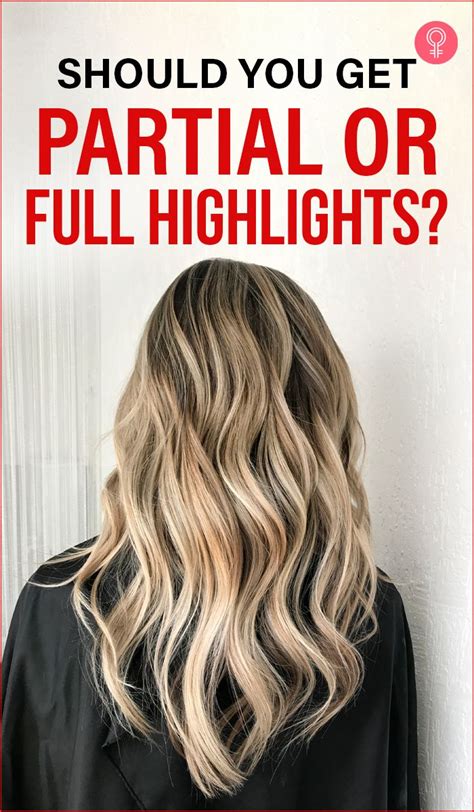Whether you’re a seasoned hair enthusiast or a newbie looking to transform your locks, choosing the right hair highlighting technique can make all the difference. Two popular options are partial highlights and full highlights, each offering distinct benefits and drawbacks. In this comprehensive guide, we’ll delve into the nuances of partial vs full highlights, empowering you to make an informed decision that complements your unique style and hair goals.

Partial Highlights
Definition: Partial highlights, also known as “lowlights,” involve selectively lightening strands of hair throughout the head, creating a subtle and natural-looking effect. This technique focuses on highlighting only specific sections, such as around the face or at the crown, to add depth, dimension, and luminosity without overwhelming the overall look.
Benefits:
- Natural-looking – Partial highlights mimic the sun-kissed effect, giving hair a refreshed, effortless glow.
- Low maintenance – Compared to full highlights, partial highlights require less frequent touch-ups, as only a portion of the hair is lightened.
- Versatile – Partial highlights can be customized to flatter various face shapes and hair colors, adding subtle accents or contrasting pops of color.
Full Highlights
Definition: Full highlights, as the name suggests, involve lightening a significant portion of the hair, creating a more dramatic and uniform effect. This technique evenly distributes highlights throughout the hair, delivering a bold and eye-catching transformation.
Benefits:
- Bold statement – Full highlights create a striking and glamorous look, adding instant volume and radiance to hair.
- Versatile – Full highlights can be tailored to different hair colors and textures, from adding golden blonde accents to creating a high-contrast platinum blonde effect.
- Camouflages gray – Full highlights effectively blend gray hairs, providing a youthful and radiant boost to your appearance.
Partial vs Full Highlights: Choosing the Right Technique
Consider Your Hair Color:
- Dark hair: Partial highlights can add subtle warmth and dimension to dark hair without overpowering the natural color. Full highlights, on the other hand, can create a more dramatic contrast, resulting in a bolder statement.
- Light hair: Both partial and full highlights can enhance light hair, adding golden or platinum blonde accents to achieve a sun-kissed or glamorous effect.
Think About Your Hair Texture:
- Fine hair: Partial highlights can add much-needed volume and movement to fine hair, as they create the illusion of thicker strands. Full highlights might weigh fine hair down, so it’s best to consult a professional stylist for personalized advice.
- Thick hair: Full highlights can effectively lighten and brighten thick hair, adding depth and dimension without compromising its natural volume. Partial highlights might get lost in thick hair, so full highlights are typically a better choice.
Consider Your Lifestyle:
- Low maintenance: Partial highlights require less frequent touch-ups, making them ideal for those with busy schedules or who prefer a more subtle and natural look.
- High impact: Full highlights demand regular touch-ups to maintain their vibrant color, making them suitable for those who desire a statement-making look and are willing to commit to frequent salon visits.
Common Mistakes to Avoid:
- Going too light: Avoid over-lightening your hair, as it can damage the hair shafts and result in breakage or discoloration.
- Overlapping highlights: Overlapping highlights can create a harsh and unnatural look, so ensure that each strand is highlighted separately.
- Ignoring hair health: Prioritize your hair’s health by using professional-grade products and following a regular haircare routine to minimize any potential damage.
Creative New Word: “Strandiance”
We introduce the new word “strandiance” to encapsulate the radiant and transformative effect of both partial and full highlights. Strandiance celebrates the vibrant interplay of light and color that highlights create, adding dimension, depth, and a touch of magic to any hairstyle.
Table 1: Key Differences Between Partial and Full Highlights
| Feature | Partial Highlights | Full Highlights |
|---|---|---|
| Coverage | Selective strands | Majority of hair |
| Effect | Subtle, natural | Bold, eye-catching |
| Maintenance | Low | High |
| Ideal for | Adding depth, dimension | Statement-making transformation |
| Suitability | Dark or light hair | Any hair color, especially thick |
Table 2: Benefits of Partial and Full Highlights
| Highlight Type | Benefits |
|---|---|
| Partial Highlights | |
| – Natural-looking | |
| – Low maintenance | |
| – Versatile | |
| Full Highlights | |
| – Bold statement | |
| – Versatile | |
| – Camouflages gray |
Table 3: Drawbacks of Partial and Full Highlights
| Highlight Type | Drawbacks |
|---|---|
| Partial Highlights | |
| – Can be less dramatic | |
| – Might not be suitable for thick hair | |
| Full Highlights | |
| – High maintenance | |
| – Can damage hair if over-lightened | |
| – Not ideal for fine hair |
Table 4: Factors to Consider When Choosing Between Partial and Full Highlights
| Factor | Partial Highlights | Full Highlights |
|---|---|---|
| Hair Color | Dark or light | Any color, especially thick |
| Hair Texture | Fine or thick | Thick |
| Lifestyle | Low maintenance preferred | High impact desired |
| Goal | Subtle enhancement | Dramatic transformation |
Conclusion
Whether you opt for partial or full highlights, embrace the transformative power of strandiance to elevate your hair’s beauty and unleash your inner glow. By carefully considering your hair color, texture, and lifestyle, you can choose the highlighting technique that best complements your unique style and hair goals. Embrace the art of hair transformation and let partial or full highlights illuminate your locks with radiant, head-turning beauty.
